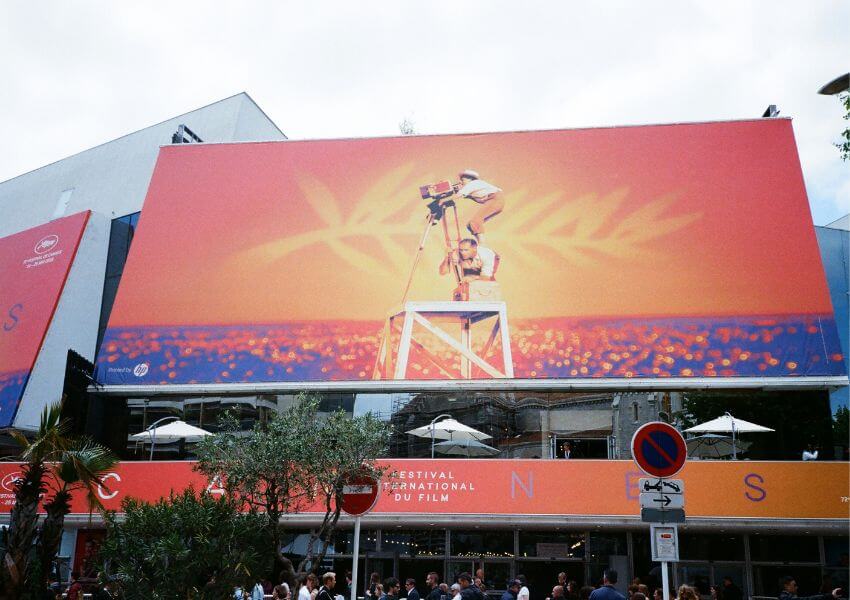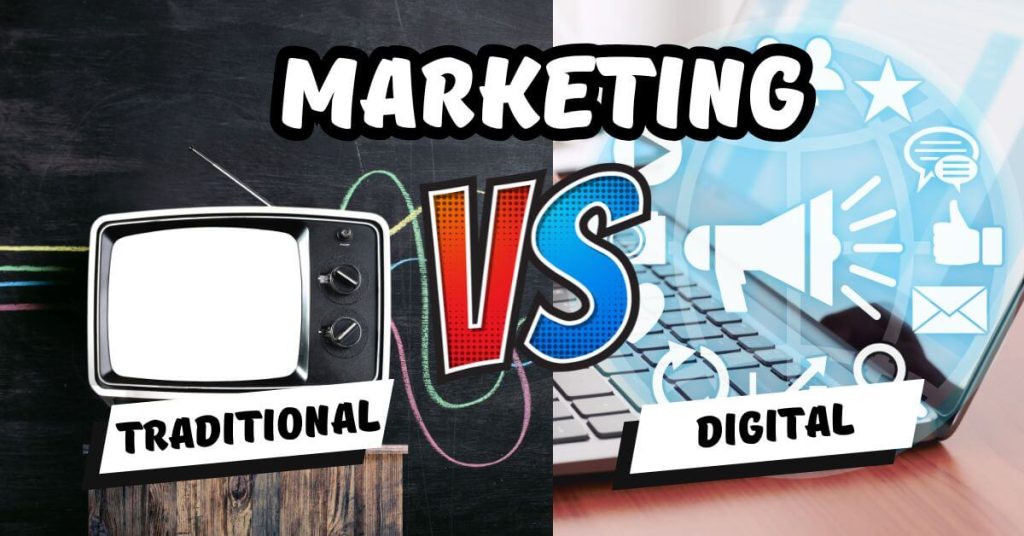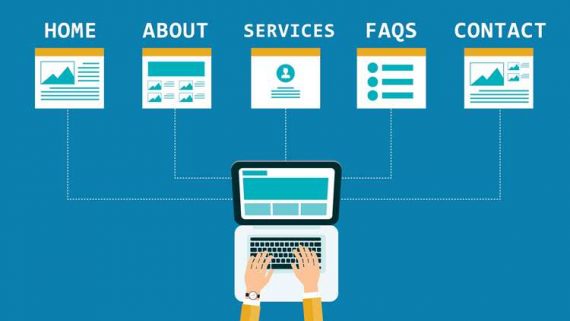Traditional vs. Digital Marketing: Which Works Better Today?
In today’s world, businesses use two main types of marketing: traditional and digital. Traditional marketing includes methods like TV ads, radio spots, and print media.
Digital marketing uses online tools such as social media, email campaigns, and websites. A recent survey showed that U.S. companies increased their digital marketing spending by 11.1% over the past year, while traditional advertising grew by only 0.8%. (Source: Statista)
This shift highlights the growing importance of digital strategies in reaching today’s consumers.
What Do We Mean by Traditional Marketing? Let’s Break It Down Together
Traditional marketing refers to the conventional methods businesses use to promote their products or services without relying on digital platforms.
In Bangladesh, these strategies have been prevalent for decades and continue to play a significant role in reaching diverse audiences.
Let’s explore some common forms of traditional marketing.
Television Advertising: Reaching the Masses
Television remains one of the most powerful mediums for reaching a large audience in Bangladesh, especially in rural areas.
For instance, during popular TV dramas or sports events, companies often showcase their products through engaging commercials.
However, TV advertising can be quite expensive, with costs varying based on the time slot and channel popularity. Prime-time slots on leading channels command higher rates, making it a substantial investment for businesses.
Radio Advertising: Capturing Ears on the Move
Radio ads engage listeners through audio messages, often during commutes or while multitasking. Local businesses frequently use radio spots to reach community members. Radio advertising is generally more affordable than television.
Costs vary based on factors like station popularity and time slots, but it’s a cost-effective way to reach local audiences.

Print Media: Tangible Promotions
This category includes advertisements in newspapers, magazines, brochures, and flyers. For example, fashion brands often showcase their latest collections in magazine spreads. Print advertising costs depend on publication circulation and ad size.
A full-page ad in a national magazine can be quite expensive, while local newspaper ads are more budget-friendly. However local newspapers are only best for localized businesses.
Billboards and Outdoor Advertising: Visibility in Public Spaces
Billboards, posters, and other outdoor ads are placed in high-traffic areas to capture the attention of passersby. For example, you would see many companies promoting their brands through LED and billboards on the roads of Dhaka, Chittagong, and Sylhet cities.

High-visibility areas like Farmgets would ask for premium prices, whereas local billboard placements are more affordable.
Direct Mail: Personalized Outreach
This involves sending promotional materials like catalogs, postcards, or brochures directly to consumers’ mailboxes. Retailers often use this method to announce sales or new products. Direct mail campaigns incur costs for printing and postage.
While more expensive than some digital methods, they can effectively target specific neighborhoods or demographics.
NOTE: Though traditional marketing is expensive, you can not ignore this format of marketing if you are running a big brand. But for small businesses traditional marketing is not recommended as they can do that with the help of digital marketing.
Enter the Digital Age: What Exactly is Digital Marketing?
Digital marketing is all about using online platforms and tools to connect with people. It offers businesses creative ways to share their messages and attract the right audience. Let’s break down the major types of digital marketing, with examples that bring them to life.
Read More: What is Digital Marketing in Bangladesh?
Search Engine Optimization (SEO): Make Your Websites Visible
SEO is the art of optimizing websites so they show up on search engines like Google. It’s like making sure your business pops up when someone searches for what you offer.
If someone in Dhaka searches for “best biryani near me,” restaurants with optimized content, keywords, and mobile-friendly designs are more likely to rank at the top.
A local restaurant using SEO might include blogs about Bangladeshi cuisine or popular food trends to attract visitors. Therefore, local businesses should take Local SEO service to promote their businesses and get instant clients when anyone performs a search for services or products they offer.
Social Media Marketing: Engaging Audiences Where They Are
Social media platforms like Facebook, Instagram, and TikTok have billions of users. Businesses use these platforms to share posts, run ads, and interact with their audience.
For example, top clothing brand Aarong often showcases its seasonal collections on Instagram, with eye-catching visuals and stories to connect with younger audiences. Many people are managing their small businesses with a Facebook page only.
If you are new to this you should take social media marketing support from a good agency to promote your brand to your target audiences. It’s not as easy a job as it seems at the beginning. You will need expert support.
Content Marketing: Telling Stories That Matter
When it comes to digital marketing, content is the most important part of your marketing strategy.
This involves creating and sharing valuable content, such as blogs, videos, infographics, or e-books. The goal is to inform or entertain while subtly promoting a product or service.
For example, an IT training center in Dhaka could write blog posts like “5 Essential Skills for Freelancers in Bangladesh” or create YouTube videos teaching basic coding. Such content attracts potential students who later enroll in their courses.
Content marketing is the most important part of your digital marketing strategy. So, you should get expert help for content marketing.
Email Marketing: Staying in Touch
Email marketing involves sending targeted messages to people’s inboxes. It can include newsletters, offers, or updates about a business. E-mail marketing not only gives you new clients but also helps you to retain your customers.
E-mail marketing is the cheapest but still effective digital marketing strategy.
E-commerce platforms like Daraz often send emails about flash sales or exclusive discounts to keep their customers informed and engaged.
Pay-Per-Click (PPC) Advertising: Getting Instant Visibility
PPC ads appear at the top of search results or on websites. Businesses pay a fee whenever someone clicks their ad.
For example, a Bangladeshi tour operator could run a “Visit Sundarbans” campaign and might use PPC ads targeting keywords like “Sundarbans tour packages.” Their ad appears immediately when users search for related terms.
Affiliate Marketing: Partnering for Growth
Affiliate marketing involves businesses partnering with individuals or other companies (affiliates) to promote their products. Affiliates earn a commission for each sale they generate.
A local tech retailer in Bangladesh might work with influencers who review gadgets on YouTube. Each review includes an affiliate link, and the influencer earns a percentage for every purchase made through that link.
Influencer Marketing: Leveraging Online Personalities
Influencer marketing focuses on partnering with popular personalities on platforms like Instagram or YouTube. These influencers promote products to their followers.
Beauty brands in Bangladesh often collaborate with makeup artists on Instagram. The influencers showcase tutorials using the brand’s products, inspiring followers to buy them.
Mobile Marketing: Reaching Users on Their Phones
Mobile marketing targets users directly through SMS, app notifications, or mobile ads. This approach ensures businesses connect with people wherever they go.
A telecom company like Grameenphone often sends SMS updates about special data offers or app-exclusive deals.
Video Marketing: Creating Visual Impact
Videos are a powerful way to communicate messages quickly and effectively. Platforms like YouTube, Facebook, and Instagram are key for video marketing.
Many new businesses in Bangladesh taking advantage of video content to reach people around the nation and promote their products. From our experience, we can say the result is very good when you use video content to promote your product or services.
Video creation is a tough task. You can help from local video marketing experts to create good quality and engaging videos.
How Do Traditional and Digital Marketing Differ? Let’s Chat About the Key Differences
Traditional and digital marketing may share the same goal—reaching customers—but they take very different routes. Let’s break down how they compare in simple terms.
Cost Matters
Traditional marketing often requires a hefty budget. TV commercials, magazine ads, and billboard spaces can cost a fortune. For example, a prime-time TV spot in Bangladesh during a popular show might set a brand back by lakhs of taka. Printing brochures or flyers adds to the bill.
Digital marketing, on the other hand, is budget-friendly. Small businesses in Dhaka can run Facebook ads for as little as a few hundred taka and still reach thousands of people. It’s a much cheaper way to get noticed, especially for startups.
Who Are They Talking To?
Traditional methods like TV or radio ads reach everyone in a general sense. Think of them as a wide net cast over a large audience, hoping to catch the right people.
Digital marketing is more like a targeted laser. Platforms like Google or Instagram allow businesses to narrow down their audience by age, interests, location, or even buying habits. For instance, an online store selling cricket gear can show ads specifically to young cricket enthusiasts in Bangladesh.
Can They See How They’re Doing?
Measuring success is tricky with traditional marketing. How many people saw a billboard or acted on a flyer? It’s hard to tell. You’re mostly guessing.
Digital marketing solves this problem. Tools like Google Analytics or Facebook Insights tell businesses exactly how their ads perform. They can track clicks, views, and even sales in real-time. For example, an e-commerce site can know within minutes how many people clicked on its latest Instagram ad.
Do We Get to Talk Back?
Traditional marketing is a one-way street. Brands speak, and we listen (or ignore). A TV ad might grab our attention, but there’s no way to respond or share thoughts.
Digital marketing invites a conversation. Businesses can reply to comments, run polls, and get direct feedback. For instance, a clothing brand posting on Instagram can instantly see what customers think of their new collection based on comments and likes.
How Far Can Their Message Go?
Traditional marketing usually stays local. Billboards, newspapers, and TV ads mostly reach people in the same region. If you’re a business in Dhaka, your ad likely won’t reach Chattogram unless you spend extra.
Digital marketing is borderless. An online ad can reach someone in Khulna, Kuala Lumpur, or anywhere else, depending on the target settings. For example, a Bangladeshi freelancer can promote their services globally through platforms like LinkedIn or Fiverr ads.
Advantages and Disadvantages of Traditional and Digital Marketing
| Aspect | Traditional Marketing | Digital Marketing |
| Cost | Expensive, like TV ads and printing brochures. | Cheaper, with low-budget options like social media ads. |
| Reach | Good for local or regional audiences. | Can reach a global audience instantly. |
| Targeting | Broad reach but not specific to any group. | Can focus on specific people based on their interests. |
| Interactivity | One-way communication, no feedback from the audience. | Two-way communication, with comments and shares. |
| Measurability | Hard to track how many people saw or acted on ads. | Easy to measure results with tools like analytics. |
| Credibility | Established media like newspapers are trusted. | Newer platforms may lack the trust of some people. |
| Learning Curve | Simple methods, no need for advanced skills. | Requires knowledge of tools and platforms. |
| Adaptability | Fixed and cannot be changed once published. | Easy to update and adjust campaigns. |
Frequently Asked Questions
Here are some common questions and straightforward answers to help clarify how traditional and digital marketing differ:
1. What is traditional marketing?
Traditional marketing uses offline channels to promote products or services. This includes methods like TV and radio ads, newspapers, magazines, billboards, and direct mail. These approaches have been used for many years to reach broad audiences.
2. What is digital marketing?
Digital marketing involves promoting products or services through online platforms. This includes social media, email campaigns, search engines, websites, and online ads. It leverages the internet and electronic devices to connect with targeted audiences.
3. How do costs compare between traditional and digital marketing?
Traditional marketing can be more expensive due to costs like printing and buying ad space on TV or in newspapers. Digital marketing often offers more cost-effective options, allowing businesses to reach specific audiences online with smaller budgets.
4. Which method offers better audience targeting?
Digital marketing provides better targeting capabilities. It allows businesses to focus on specific demographics, interests, and behaviors, ensuring the message reaches the right people. Traditional marketing typically casts a wider net without precise targeting.
5. How can I measure the success of my marketing campaigns?
Digital marketing offers real-time analytics, enabling businesses to track metrics like clicks, shares, and conversions. This makes it easier to measure success and return on investment. Traditional marketing lacks precise measurement tools, making it harder to assess campaign effectiveness.
6. Which approach is better for my business?
The choice depends on your target audience and goals. Digital marketing is effective for reaching specific groups and offers measurable results. Traditional marketing can be beneficial for reaching broader or local audiences. Often, a combination of both strategies works best.
Wrapping It Up: Why Choose Digital Marketing for Your Business?
Marketing has evolved, and the shift from traditional to digital methods is clear. Digital marketing offers unmatched benefits, like targeted reach, cost-effectiveness, and real-time insights, making it a game-changer for businesses in today’s fast-paced world.
If you’re looking to take your marketing efforts to the next level, we’re here to help! Our digital marketing services are tailored to meet your unique needs, ensuring your business reaches the right audience and achieves measurable results.
Whether you’re starting fresh or scaling up, let us be your partner in growing your online presence. Reach out today and let’s make your marketing goals a reality! You can contact us for a free consultation.









Comments
Comments are closed.